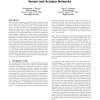Free Online Productivity Tools
i2Speak
i2Symbol
i2OCR
iTex2Img
iWeb2Print
iWeb2Shot
i2Type
iPdf2Split
iPdf2Merge
i2Bopomofo
i2Arabic
i2Style
i2Image
i2PDF
iLatex2Rtf
Sci2ools
IPSN
2007
Springer
2007
Springer
Power scheduling for wireless sensor and actuator networks
We previously presented a model for some wireless sensor and actuator network (WSAN) applications based on the vector space tools of frame theory. In this WSAN model there is a weight associated to each sensor-actuator link denoting the importance of that communication link to the actuation fidelity. These weights were shown to be useful in pruning away communication links to reduce the number of active channels. Inspired by recent work in power scheduling for decentralized estimation, we investigate the optimal allocation of system resources for achieving a desired actuation fidelity. In this scheme, each sensor acquires a noisy observation and sends a message to a subset of actuators using an MQAM transmission strategy. The message sent on each sensor-actuator communication link is quantized with a variable number of bits, with the number of bits optimized to minimize the total network power consumption subject to a constraint on the actuation distortion. We show analytically and ...
| Added | 08 Jun 2010 |
| Updated | 08 Jun 2010 |
| Type | Conference |
| Year | 2007 |
| Where | IPSN |
| Authors | Christopher J. Rozell, Don H. Johnson |
Comments (0)

